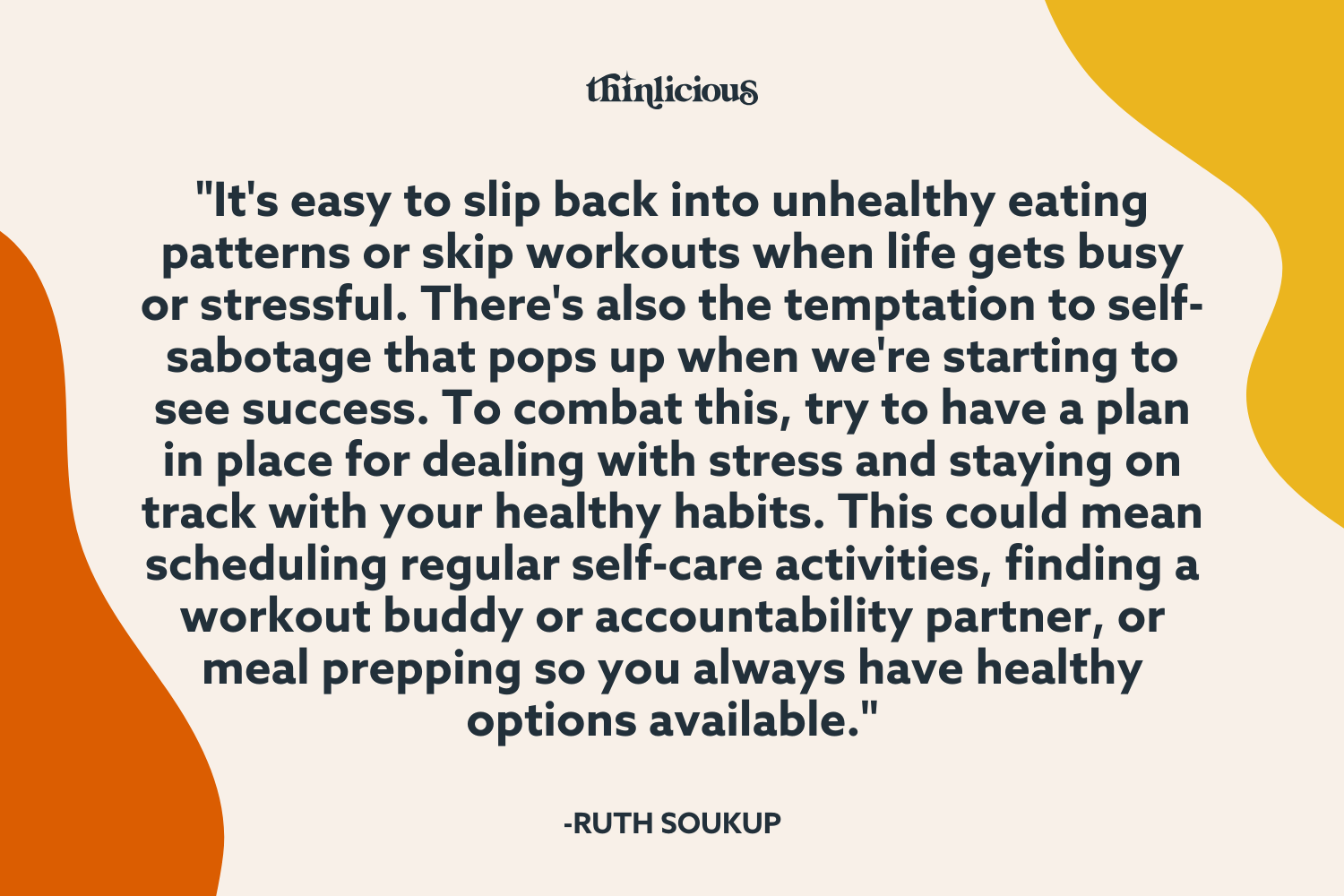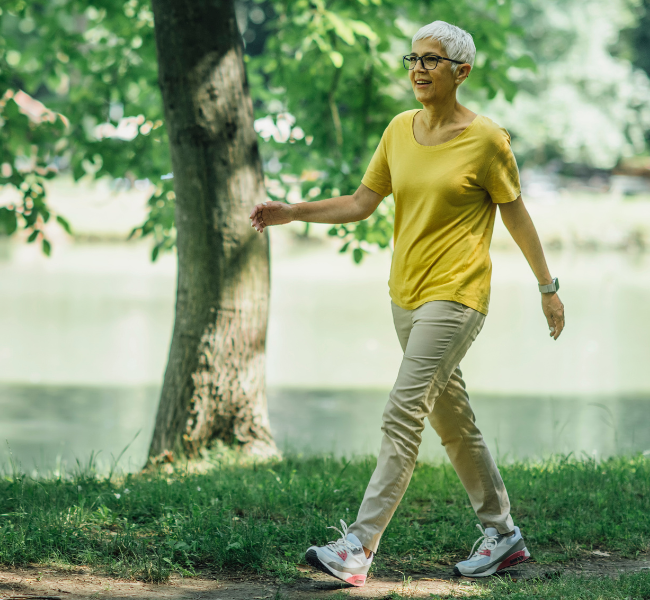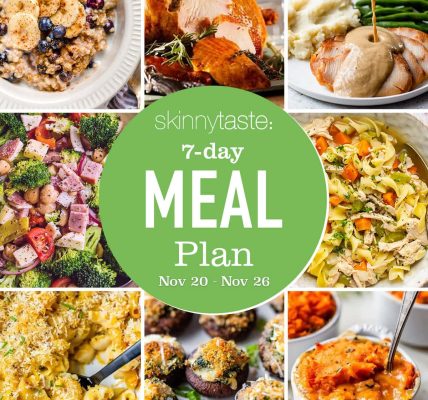Ever feel like you must be the ONLY one in the world who can’t seem to get this healthy eating thing right? That while everyone else is out there losing weight and getting fit, you’re just stuck spinning your wheels, gaining and losing the same 5 pounds over and over again?
If so, I want you to know that you are definitely NOT alone. In fact, just about every single woman I’ve ever met who has struggled with weight loss has told me that at some point, they’ve felt exactly the same way.
And that’s why in today’s post I want to talk about something that I think will be really helpful for you to understand—the 4 stages of healing your metabolism, and why it’s so important to recognize where you are in the process.
And the reason I think this is so important is because SO many of us—so many women who have struggled with their weight and with emotional eating and with getting healthy—we all have this tendency to be really, really hard on ourselves. We have a tendency to blame ourselves when things don’t go right, to tell ourselves that we’re not good enough, or that we don’t have enough willpower, or that we’re just not cut out for this. We have a tendency to see all of our failures and all of our struggles as being a direct result of something that we’re doing wrong, or something that’s wrong with us.
And that’s why I think it’s so important to recognize that when it comes to healing your metabolism and getting healthy and losing weight in a way that is actually sustainable and that will actually work long term, there is a PROCESS that you have to go through. It’s not something that’s going to happen overnight, and it’s not something that’s going to happen just because you decide to go on one more diet. And even if you’re doing all the right things, and you’re following all the right advice, there are still certain things that need to happen in your body, and in your metabolism, in order for you to start seeing real, lasting results.
Are you ready to lose weight and heal your body for life (without dieting, drugs, or making yourself miserable)?

Our free on-demand video training will walk you through how to make this THE year you set health goals…and keep them.
And so that’s what I want to dive into today. I want to talk about these 4 stages of healing your metabolism, and what each of these stages looks like, and what you can expect in each stage. And I also want to talk about some of the common roadblocks and struggles that a lot of women face in each of these stages, and what you can do to overcome them.
But before we dive in, there is something I do want to tell you real quick, I suppose a little bit of a disclaimer. And that is that while I am NOT a doctor, and I am NOT a medical professional, I HAVE done a LOT of research on this topic, and I have also worked with a lot of doctors and experts in the field of metabolic health and weight loss, and I have also worked with a lot of women in our Thinlicious program who have all been through this process, and who have all had to heal their metabolism in order to lose weight. And so a lot of what I’m going to be sharing with you today is based on that research and that experience.
But that being said, everyone’s body is different, and everyone’s journey is going to look a little bit different. And so while I think it’s really helpful to have a general understanding of these 4 stages and what to expect, I also want to encourage you to be patient with yourself, and to not get too caught up in trying to fit yourself into some kind of a box or a specific timeline.
Because the reality is that it may take you a little bit longer to get through one stage, or you may need to spend more time in one stage than someone else, and that’s totally okay. What’s most important is that you keep moving forward, and that you keep making progress, no matter how slow that progress may feel at times.
So with that little disclaimer out of the way, let’s go ahead and dive into these 4 stages of healing your metabolism.
Stage 1: Inflammation
The first stage of healing your metabolism is what I like to call the Inflammation stage. And this is the stage where you really have to focus on reducing inflammation in your body in order to start the healing process. Because the reality is that for a lot of us, our bodies are just so inflamed, and have been so inflamed for so long, that it’s actually preventing us from being able to lose weight and get healthy. And so this first stage is really all about addressing that inflammation and getting it under control.
Now, one of the things that’s really important to understand about inflammation is that it’s not just one thing—it’s actually a whole bunch of different things that are all happening in your body at the same time. And so in order to effectively address inflammation, you have to be willing to take a really holistic approach, and to look at all of the different factors that could be contributing to inflammation in your body.
And this is something that I think a lot of us don’t always realize—we don’t always realize how interconnected everything in our body really is, and how one thing can have a domino effect on everything else. So for example, if you’re not getting enough sleep, or if you’re really stressed out, or if you’re not drinking enough water, or if you’re not eating the right foods, or if you have a leaky gut, or if you have food sensitivities, or if you have hormonal imbalances, or if you have an autoimmune condition, or if you’re taking certain medications, or if you’re exposed to toxins in your environment—all of these things can contribute to inflammation in your body.
And so in this first stage, the goal is really to start addressing all of these different factors, and to start making some changes in your lifestyle and in your diet that will help to reduce inflammation.
And the good news is that once you start doing that, you’ll probably start to notice some pretty significant changes in how you look and feel, even if the number on the scale isn’t moving yet. You’ll probably notice that you have more energy, and that you’re sleeping better, and that your skin looks better, and that you’re not as bloated, and that your clothes are fitting a little bit better. And those are all really good signs that you’re on the right track.
But the thing to keep in mind about this first stage is that it can take a little while—for some people, it might only take a few weeks, but for others, it could take a few months. Because the reality is that it’s probably taken you a long time to get to this point, where your body is so inflamed and so out of whack, and so it’s going to take a little while for all of these changes to really start to have an impact.
And that’s okay—it’s important to be patient with yourself, and to give yourself the time that you need to really start to see and feel the changes.
Common Roadblocks in the Inflammation Stage
But that being said, there are also a few common roadblocks that a lot of women tend to face in this first stage, and so I want to talk about those for a minute, and also give you some tips for how to overcome them.
The first common roadblock that a lot of women face in this Inflammation stage is what I like to call the “detox flu.” And this is basically when you start to make some changes in your diet and in your lifestyle to reduce inflammation, and your body starts to go through a bit of a detox process, and you end up feeling really tired and fatigued, and maybe even a little bit sick to your stomach. And this can be really discouraging, because you’re trying to do all the right things, but you just feel like crap.
And so if this happens to you, my best advice is to just be really gentle with yourself, and to listen to your body. It’s okay to take things slow, and to not try to do everything all at once. And it’s also really important to make sure that you’re staying hydrated, and getting enough rest, and that you’re not pushing yourself too hard. And if you need to, it’s okay to take a little break from some of the more intense changes that you’re making, and to just focus on the things that feel doable for you right now.
The second common roadblock that a lot of women face in this first stage is that they start to feel really overwhelmed with all of the changes that they know they need to make. And this is totally understandable, because like I said, there’s a lot of different factors that can contribute to inflammation in your body, and so it can feel like you have to change everything, all at once. And that’s not only really hard to do, but it’s also not very sustainable in the long run.
And so if this happens to you, my best advice is to just focus on one thing at a time. Pick one small change that you can make, and then once you feel like you’ve got that under control, move on to the next thing. And don’t try to do it all by yourself—find an accountability partner, or join a group, or work with a coach, or just get your family on board. Having that support and accountability can make a really big difference.
The third common roadblock that a lot of women face in this first stage is that they start to see some progress, and they start to feel really good, but then they get a little bit complacent, and they go back to their old habits. And then they wonder why they start to feel like crap again. And this is something that I see happen a lot, and it’s something that I’ve even experienced in my own life.
And so if this happens to you, my best advice is to just be really mindful and aware of your triggers, and the things that tend to cause you to revert back to your old habits. And then come up with a plan for how you’re going to deal with those triggers when they come up. And also be willing to give yourself a little bit of grace—it’s okay to have a bad day, or to indulge every once in a while. What’s most important is that you don’t let that one bad day turn into a whole bad week, and that you just keep moving forward.
The fourth common roadblock that a lot of women face in this first stage is that they’re not being consistent with the changes that they’re making. And this is probably the biggest roadblock of all, because the reality is that you can make all the right changes, but if you’re not consistent, then you’re not going to see the results that you want. And I know that’s probably not what you want to hear, because it’s so much easier to just blame yourself and say that it’s not working, but the truth is that if you’re not being consistent, then you’re the one getting in your own way.
And so if this is something that you struggle with, my best advice is to just try to find a way to make it more sustainable for you. And that might mean making smaller changes, or finding healthier alternatives to your favorite foods, or just finding a way to make it more enjoyable for you. Because the reality is that if it feels like a chore, and if it feels like something that you can’t sustain long term, then you’re probably not going to be consistent with it.
So those are some of the common roadblocks that a lot of women tend to face in this first Inflammation stage. And hopefully some of those tips will be helpful for you, if you find yourself struggling with any of them.
Okay, so let’s move on to the next stage.
Stage 2: Insulin Resistance
The second stage of healing your metabolism is what I like to call the Insulin Resistance stage. And this is the stage where you really have to focus on reversing insulin resistance in your body, in order to start seeing real, lasting results with your weight loss and your overall health. Because the reality is that for a lot of us, especially those of us who have been struggling with our weight for a long time, and who have been on and off diets for years, we’ve probably developed a pretty significant level of insulin resistance, and that’s what’s been preventing us from being able to lose weight and get healthy.
And so in this second stage, the goal is really to start reversing that insulin resistance, and to start healing your body from the inside out. And the good news is that if you’ve already been making some changes in the first stage to reduce inflammation, a lot of those same changes will also help with insulin resistance. But there are also some additional things that you can do in this second stage to really focus on that, and I’ll talk about that in a minute.
But first, I want to make sure that we’re all on the same page about what insulin resistance actually is, and why it’s such a big deal. Because I know that a lot of times, we tend to think of insulin as just being that thing that helps us regulate our blood sugar, and that if we have to much sugar, then our body releases too much insulin, and that’s what causes us to gain weight. And while that’s not entirely wrong, it’s also a really oversimplified way of looking at it.
Because the reality is that insulin is actually a hormone, and it’s a really important hormone, because it’s what allows our cells to take in glucose and use it for energy. And so when we eat carbohydrates and sugar, our body releases insulin to help regulate our blood sugar and to allow our cells to take in that glucose. And that’s all fine and good, except for the fact that for a lot of us, we’ve been eating SO many carbohydrates and SO much sugar for SO long, that our body has basically become desensitized to insulin. In other words, our cells have stopped responding to insulin the way that they’re supposed to.
And when that happens, a few different things start to go wrong. The first thing is that our body starts to produce more and more insulin, in an effort to try to get our cells to respond. And this is why a lot of people who struggle with insulin resistance also have high levels of insulin in their blood. But the problem is that all that extra insulin can actually cause our cells to become even more resistant, which just creates a vicious cycle.
But the other thing that happens when our cells are no longer responding to insulin is that our body starts converting all those excess carbohydrates and sugar into fat—and not just any fat, but belly fat. So if you’ve ever wondered why it seems like no matter how much you exercise or how little you eat, you just can’t seem to lose weight in your midsection, it’s probably because of this whole insulin resistance thing.
So what can we do to reverse insulin resistance and start seeing real results? Well, the first thing is to continue with all of the changes that you started in the first stage. Things like reducing your sugar intake, eating more whole foods, and managing stress are all really important for both inflammation and insulin resistance.
But there are also some specific things that you can do to target insulin resistance specifically. And one of those things is to focus on incorporating more healthy fats into your diet. I know this might seem counterintuitive, because we’ve been told for so long that fat is bad for us and causes weight gain. But the truth is that healthy fats are essential for hormone balance, including insulin. So make sure you’re really getting a high percentage of fat in your diet—probably way more than you’re used to.
Another important aspect of reversing insulin resistance is to be mindful of your carbohydrate intake. At this phase, you’ll still want to keep your carbs super low and also avoid sugar and processed food as much as possible.
And finally, exercise can also play a huge role in reversing insulin resistance. Regular physical activity helps to increase our body’s sensitivity to insulin, making it easier for our cells to respond properly. So find activities that you enjoy and make them a regular part of your routine.

Common Roadblocks in the Insulin Resistance Stage
So what are some of the big roadblocks that can pop up during the Insulin Resistance stage?
Well, first of all, there’s the cravings. You know, those moments when your brain decides that the most urgent thing in the world is a double chocolate fudge cake (with sprinkles, of course)? It’s like your body turns into a toddler having a meltdown in the candy aisle. Understanding that these cravings are often tied to fluctuating blood sugar levels can help. Instead of succumbing, try to keep your pantry stocked with healthy snacks—think nuts, veggies with hummus, or even some dark chocolate (yes, you heard me right).
The second big roadblock I see most often in this stage is IMPATIENCE.
Because when you’re working hard to get healthy, it can be really frustrating to not see immediate results. Basically it’s like waiting for your bread to toast—everything feels a little too slow!
Except you’re not really eating toast because it has too many carbs so maybe that’s a bad analogy…
Anyway..
My point is that progress takes TIME.
The reality is that your body didn’t get to where you are right now overnight, and healing your metabolism isn’t going to happen overnight either.
So try to celebrate the small wins and the non-scale victories, like fitting into your favourite jeans again or having more energy to chase after your kids (or pets).
And don’t forget about the importance of support in this stage! Having a friend or the support of a community who shares your goals can keep you motivated when your resolve starts to waver.
Stage 3: Repair
The third stage of healing your metabolism is all about repair. By now, you’ve made some serious progress in terms of reducing inflammation and reversing insulin resistance. But there may still be some underlying imbalances that need to be addressed in order for your metabolism to function optimally.
One area that often needs attention at this stage is gut health. Our digestive system plays a huge role in our overall health, and imbalances in the microbiome can lead to a whole host of issues including weight gain, food sensitivities, and even bloating.
To support gut health, focus on incorporating probiotic-rich foods like fermented vegetables or yogurt into your diet. You may also want to consider taking a high-quality probiotic supplement.
In addition to gut health, this stage is also a good time to address any hormonal imbalances that may be causing issues with your metabolism. This could include imbalances in thyroid hormones, cortisol levels (the stress hormone), or sex hormones.
If you’re not seeing significant progress at this phase, sometimes working with a healthcare professional who specializes in functional medicine can help you identify and address any underlying hormonal imbalances.
This is the stage where you’ll also want to start working on building strength and increasing lean muscle mass by adding in weight training and other fat burning exercise to rev up your metabolism even more.
But overall, this is the phase where you’ll really start to feel like you’re living a sustainable, healthy lifestyle. Your energy levels will be higher, your cravings will be under control, and you’ll have a better understanding of how different foods affect your body.
Your body will be healing, your health markers will be dramatically improved, you’ll likely be losing weight at a steady pace (even if it’s slower than what you’d like), and you’ll probably be able to start reducing or eliminating medications that you were previously dependent on.
So even though it may take some time and effort to get here, trust me when I say that the results are well worth it. That said, it doesn’t mean there won’t still be a few roadblocks along the way that you’ll need to watch out for.
Common Roadblocks in the Repair Stage
So what are some of the big roadblocks that can pop up during the REPAIR stage of healing your metabolism?
One common issue is falling back into old habits. It’s easy to slip back into unhealthy eating patterns or skip workouts when life gets busy or stressful. There’s also the temptation to self-sabotage that pops up when we’re starting to see success.
To combat this, try to have a plan in place for dealing with stress and staying on track with your healthy habits. This could mean scheduling regular self-care activities, finding a workout buddy or accountability partner, or meal prepping so you always have healthy options available.
Another roadblock that can occur at this stage is impatience (again!). Even though you may be seeing progress and feeling better overall, it’s important to remember that healing takes time. Don’t expect overnight results and continue to focus on the small wins along the way.
And finally, don’t forget about the importance of self-care. This stage can be a lot of work as you’re trying to address underlying imbalances and build strength, so it’s important to prioritize taking care of yourself both physically and mentally. This could mean getting enough sleep, practicing relaxation techniques like meditation or yoga, or simply taking some time for yourself each day to do something you enjoy.

Stage 4: Metabolic Flexibility
And now we come to the final stage of healing your metabolism—Metabolic Flexibility. This is the stage where you’ll finally be able to enjoy a balanced, sustainable approach to healthy living.
And this is your ultimate goal!
By this point, your metabolism should be functioning optimally and you’ll have a good understanding of what foods support your body and which ones don’t. You’ll also be in tune with your hunger and fullness cues, making it easier to maintain a healthy weight without restrictive diets or constant calorie counting.
In this stage, it’s important to continue prioritizing self-care and stress management as they are key components of maintaining optimal metabolic function. It’s also important to continue incorporating strength training into your workout routine to maintain muscle mass and keep your metabolism revving.
But perhaps most importantly, this is the stage where you can start to find balance and flexibility in your diet. This means enjoying a wide variety of foods, including treats in moderation, without feeling guilty or restricted.
This is the stage that I’ve been in for over two years now, and I can tell you—especially after having struggled with my weight for SO long—that it is truly an awesome place to be.
And if you want to hear more about exactly what life looks like for me in this phase, I’ve actually recorded a whole podcast episode on it, titled “Yes I Actually Do Eat carbs. Here’s Why it Matters.”
So go back and listen to that if you’re interested.

But the biggest thing I hope you take away from THIS blog post is that healing your metabolism takes TIME. It’s not going to happen overnight. And it’s not going to happen all at once.
So while it may seem like a long journey to get here, remember that the end goal is not just weight loss or even improved health markers—it’s about finding long-term balance and sustainability for both your physical and mental well-being.
And by the way, you should also know that my TAS program is designed to walk you through all these different phases of healing your metabolism, because your nutritional needs and focus are different at each phase.
So if you want to find out more about the program and how it works, be sure to check out my free training, which you can access it HERE.









